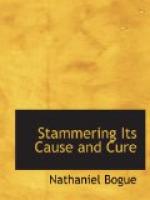STUTTERING
Stuttering may be generally defined as the repetition—rapid in some cases, slow in others—of a word or a syllable, before the following word or syllable can be uttered. Stuttering may take several forms, any one of which will fall into one of four phases:
(1)—Simple Phase (2)—Advanced Phase (3)—Mental Phase (4)—Compound Phase
Simple stuttering can be said to be a purely physical form of the difficulty. The Advanced Phase marks the stage of further progress where the trouble passes from the purely physical state into a condition that may be known as Mental-Physical. The distinctly Mental Phase is marked by symptoms indicating a mental cause for the trouble, the disorder usually having passed into this form from the simple or advanced stages of the malady. Stuttering may be combined with stammering in which case the condition represents the Compound Phase of the trouble.
Choreatic stuttering: This originates in an attack of Acute Chorea or St. Vitus Dance, which leaves the sufferer in a condition where involuntary and spasmodic muscular contractions, especially of the face, have become an established habit. This breaks up the speech in a manner somewhat similar to ordinary stuttering. Also known as “Tic Speech.”
Spastic speech: This is often the result of infantile cerebral palsy, the characteristic symptom of the trouble being intense over-exertion, continued throughout a sentence, the syllables being equal in length and very laboriously enunciated. In spastic speech, there is present a noticeable hyper-tonicity of the nerve fibers actuating the muscles used in speaking as well as marked contractions of the facial muscles.
Unconscious stuttering: This is a misnomer because there can be no such thing as unconscious stuttering. It appears that the person afflicted is not conscious of his difficulty for he insists that he does not s-s-s-s-tut-tut-tut-ter. Unconscious Stuttering is but a name for the disorder of a stutterer who is too stubborn to admit his own difficulty.
Thought stuttering: This is an advanced form of stuttering which is also known as Aphasia and which is caused by the inability of the sufferer to recall the mental images necessary to the formation of a word. Stuttering in its simpler forms is usually connected with the period of childhood, while aphasia is often connected with old age or injury. The aphasic person is excessively nervous as is the stutterer; he undergoes the same anxiety to get his words out and the same fear of being ridiculous. In aphasia there is, however, no excessive muscular tension or cramp of the speech muscles. In these cases, the stutterer will sometimes repeat the first syllable ten or fifteen times with pauses between, being for a time unable to recall what the second syllable is. It is, in other words, a habitual, but nevertheless temporary, inability to recall to mind the mental images necessary to produce the word or syllable desired to be spoken. This condition is more commonly known as Thought Lapse or the inability to think of what you desire to say.




